|

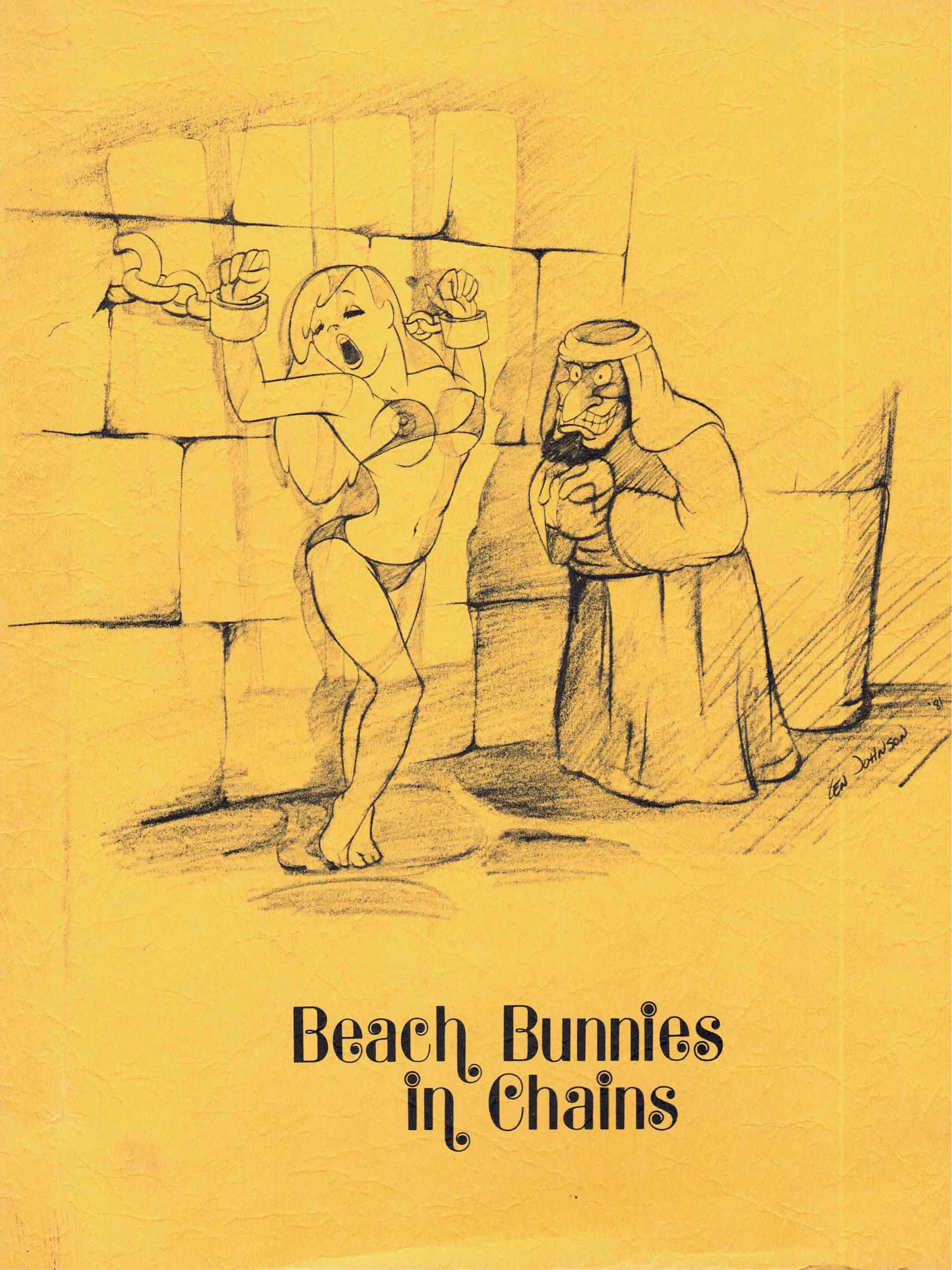
The cover to our first assignment, and no, you can't read it! |
My first contracted work on a screenplay occurred in 1980, for a guy named Marvin Jones on a project called "BEACH BUNNIES IN CHAINS." I was 19 years old -- barely old enough to watch the R-rated drive-in movie I was going to write. DAVE HINES and I drove up from San Diego County for a production meeting with the actors, choreographer(!), and other production members at Marvin's Los Angeles apartment, which had an enema bag hanging up in the bathroom.
After that we met the director, Paul Bartel, as he was screening scenes from his upcoming film, "EATING RAOUL," for the National Lampoon (my favorite humor magazine -- a good sign), with the hopes that they would finance the rest of the production, and it would be their follow-up to "ANIMAL HOUSE."
National Lampoon didn't like "EATING RAOUL." At all. We sat quietly in the back of the screening room as they left. Bartel cursed loudly as he packed up his things and took us to eat at a restaurant in the area, where the waiters all recognized Bartel, and performed songs and comedy bits for him as they brought us our food and drinks. I'm going to assume they weren't charging Bartel for the drinks, because he got HAMMERED. (We didn't drink -- 19-years-old, remember?) Bartel then drove us -- swerving and weaving drunkenly -- to an LA film festival in which he was a judge. We watched a sub-titled foreign film I don't remember -- but I do remember hearing Bartel snore next to me as it was playing. When the film ended and the lights came up, Bartel said something derisive about it and drove us back to our car (which I think was my parents' station wagon.)
It was the greatest night of my life. I was in the film business!
"EATING RAOUL" went on to be a financial success while the mighty National Lampoon died a slow, miserable death. The movie business was wide open in the early eighties -- you busted your ass to work on ANYTHING: Drive-in sex flicks, slasher films, direct-to-VHS music video stories -- and if you made any kind of money with the project, they gave you another job. You weren't slumming it with degrading, exploitative crap -- you were just breaking in! After all, a decade before us, Coppola and Scorsese had made drive-in movies for schlockmeister Roger Corman; Spielberg had been an intern at Universal, borrowing film equipment for his own shorts; Dave and I? We wrote a pirate movie parody in a Community College film class, and got lucky: Dave met a guy named Scot Holton, who made soundtrack LPs for Varèse Sarabande. Scot in turn got our pirate script to an assistant for the producer Ed Pressman -- Marvin -- who didn't in turn pass it on to Ed Pressman like a responsible production assistant, but who instead handed us an idea for his own film. He had a 23-page treatment that he had written with his partner, Hugh Harrison, and there wasn't a page that didn't have something rapey, gratuitous and offensive oozing off the margins. Marvin found us ready to break into the business like Spielberg, Coppola and Scorsese (not that we were as talented as those people, just meaning that we were willing to work for free). But instead of just writing Marvin's sleazy story ideas in drive-in movie form, we subverted the treatment. We had just seen "AIRPLANE," and we used that film as the inspiration to parody sleazy drive-in movies, and beach movies in general.
Needless to say, our script for "BEACH BUNNIES IN CHAINS" was never made, but it was good enough that it got the attention of real filmmakers, like Bartel, director Stan Dragoti, and a producer named Dimitri Villard -- and it got us our next job. About a year later, Dimitri contacted us with an idea for a vampire movie. The story, which we titled "NIGHTLIFE," would feature a female vampire who bit men in the... shall we say, groin-al area. He would pay us $2000 to write a first draft (which isn't a lot for three months of work -- especially split two ways -- but it was $2000 more than Marvin paid us). In those days, there was no "Final Draft" program on your computer to format your writing and organize the scenes of your story. There weren't even computers -- at least not computers that were cheap enough for two 19-year-olds living on a thousand dollars for three months. Instead, screenwriters used clunky manual typewriters (if you misspelled a word, you'd have to wait five minutes for the liquid paper to dry in order to correct a typo, or you just started over again on a new page), and to save money on paper and typewriter ribbons, you first filled out the storylines on 3"x5" index cards...
|

"ONCE BITTEN"
(1985, written with Dave Hines) was the release title for the script we called "NIGHTLIFE." We negotiated our own deal with the Samuel Goldwyn Company, without an agent, and after two years of rewriting it, I was so broke that I ended up working for minimum wage at Sam Goody while my film, #1 at the box office, was playing across the street. It was Jim Carrey's first (and almost last) movie. This page features backstage stories, deleted scenes and music that you won't find anywhere else, and a lot of other forgettable trivia. Enjoy! |
|
"A LITTLE BODY (OF) WORK"
(1993, written with Dave Hines) was the only animation project that I ever had produced, after studying to actually become an animator in college. It was an episode of the TV series, "TALES FROM THE CRYPTKEEPER," in which the network told us that we couldn't have anybody die (um... isn't he a "CRYPTKEEPER???"). Anyway, the story of its creation plainly lays out why kids' TV in the 1990s completely sucked. (Although fans of the more adult TFTC shows and comics seem to have a soft spot for this episode.) |
|
"DESPERATE BUT NOT SERIOUS"
(1999, Creative Consultant with Dave Hines and Rodney Lee Conover) should have been an Indie classic but it was derailed, deconstructed and destroyed by studio liars, crooks and thieves, who locked the script before we could fix it and then pocketed most of the production money. (It's still a cute movie, though, thanks to the performances.) A year later, the studio was out of business, owing $90 million to backers who successfully sued them for fraud. I have no idea who owns this film, now. See deleted scenes, the script we couldn't make, and other stuff that I hope doesn't get me sued. |
|
"BACHELORMAN"
(2003, written with Dave Hines and Rodney Lee Conover, Co-Produced with Dave Hines; Produced by Conover) took about eleven years to get made, but eventually won awards at 26 different film festivals around the world (including three Best Screenplay awards), before lasting less than two weeks in commercial theaters. See behind-the-scenes footage, animation roughs, and other fun stuff. Nobody else did! |
|
"PIRATE CAMP"
(2007, Co-Produced with Dave Hines, Creative Consultant with Dave Hines) was a straight-to-video kids' film that starred John Kassir as Blackbeard's severed head (my second project with him; he was the voice of the Cryptkeeper in "TALES FROM THE CRYPTKEEPER"), and a very unhappy Corbin Bernsen, who would call me late at night complaining about the cheap costumes and the director, who got fired mid-way through the shoot. I don't think I've ever watched this one all the way through. Even my six-year-old son quit watching it and played Captain Jack Sparrow in the backyard, instead. |
|
"HOLIDAY BAGGAGE"
(2008, Creative Consultant) was a Hallmark Channel Christmas movie starring Cheryl Ladd and Barry Bostwick. They express-mailed me the script to fix about a week before shooting began, but before my first page was turned in the payment model went from "I'll cut you a check" to "payment deferred." So I stopped writing and my contributions are limited to little 'romantic tension' moments from the first pass, like Barry giving ex-wife Cheryl a shoulder massage and saying, "That's funny -- I thought massages were supposed to make you less tense." It keeps showing up every Christmas, like moldy, re-gifted fruitcake. |
|
|



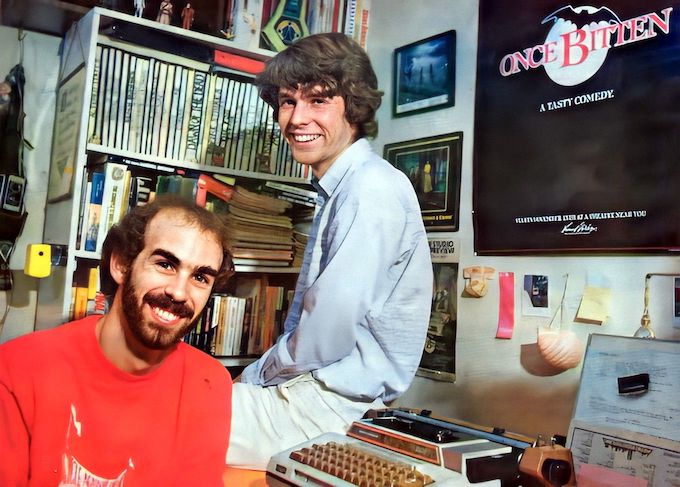
Fresh-faced H&H, posing to promote a film they hated in 1985. |
Imagine two quiet, introverted, nervous 19-year-olds who avoid any kind of drama or confrontation in their lives, and then try to determine their best career path. One occupation that would not come to mind would be a job in the performing arts. Dave Hines and I, however, chose to become screenwriters. "Dramatists," as they are also known, revel in tension and conflict. Not only do they love to write stories featuring that stuff -- using things like treachery, betrayal, double-crossing, abuse, and violence -- they love to engage in that stuff in real life as well, and often do so as they fight for their creative lives with production executives, directors, actors, dejected girlfriends, and disappointed mothers who hoped they would be grandmas by now. They're confident, combative and assertive.
Now, Dave and I were nothing like those people. In fact, we even avoided conflict in our screenplays! There were no fights, infidelities, murder -- no real conflicts -- just lots of passive/aggressive mumbling and complaining. Our exasperated agent once called us to demand rewrites on our spec script in which a crazy animated cartoon character escaped into reality... only to be trapped in a house watching TV for 60 pages. That lack of story dynamics in our scripts left us as primarily gag men -- whose jokes would actually deflate the arguments and break the tension, avoiding any uncomfortable "drama" (in screenwriting, there is a fine line between escapism and escape). Occasionally we broke through: After we finally let the cartoon character outside in the next draft of our spec, we sold it for half a million dollars.
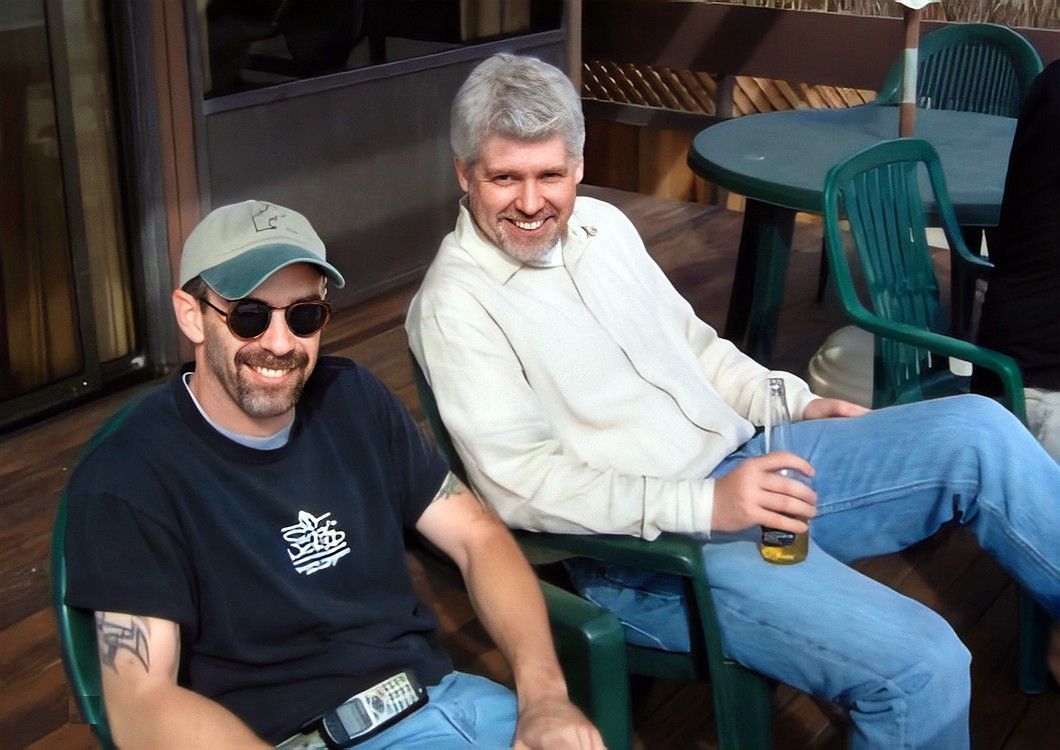
H&H in 2005 -- having aged 30 years in 20. |
Our characters never lied, or cheated, or did dirty things like sex (because we would start giggling with embarrassment as we wrote, which turned into hysterics, and then we would finally give up on the scene and change it to something else). We filled our screenplays with visual and verbal jokes that made enough noise to distract readers from noticing that absolutely nothing dramatic was happening. The thing is, we were pretty good at jokes, so we sold a lot of stuff... but precious few projects went forward with us still attached (they would bring in the emotive writers who could add conflict and drama for that).
Still, our careers lasted 25 years. We worked with some of the best people in show business, got a few movies made, and I look back on that period with some pride. What follows are compendium scripts featuring my favorite scenes for films that were produced, as well as screenplays that came close to production, but fell apart for some reason or other. They may not be fiery or combative -- but you will laugh, at least.
|
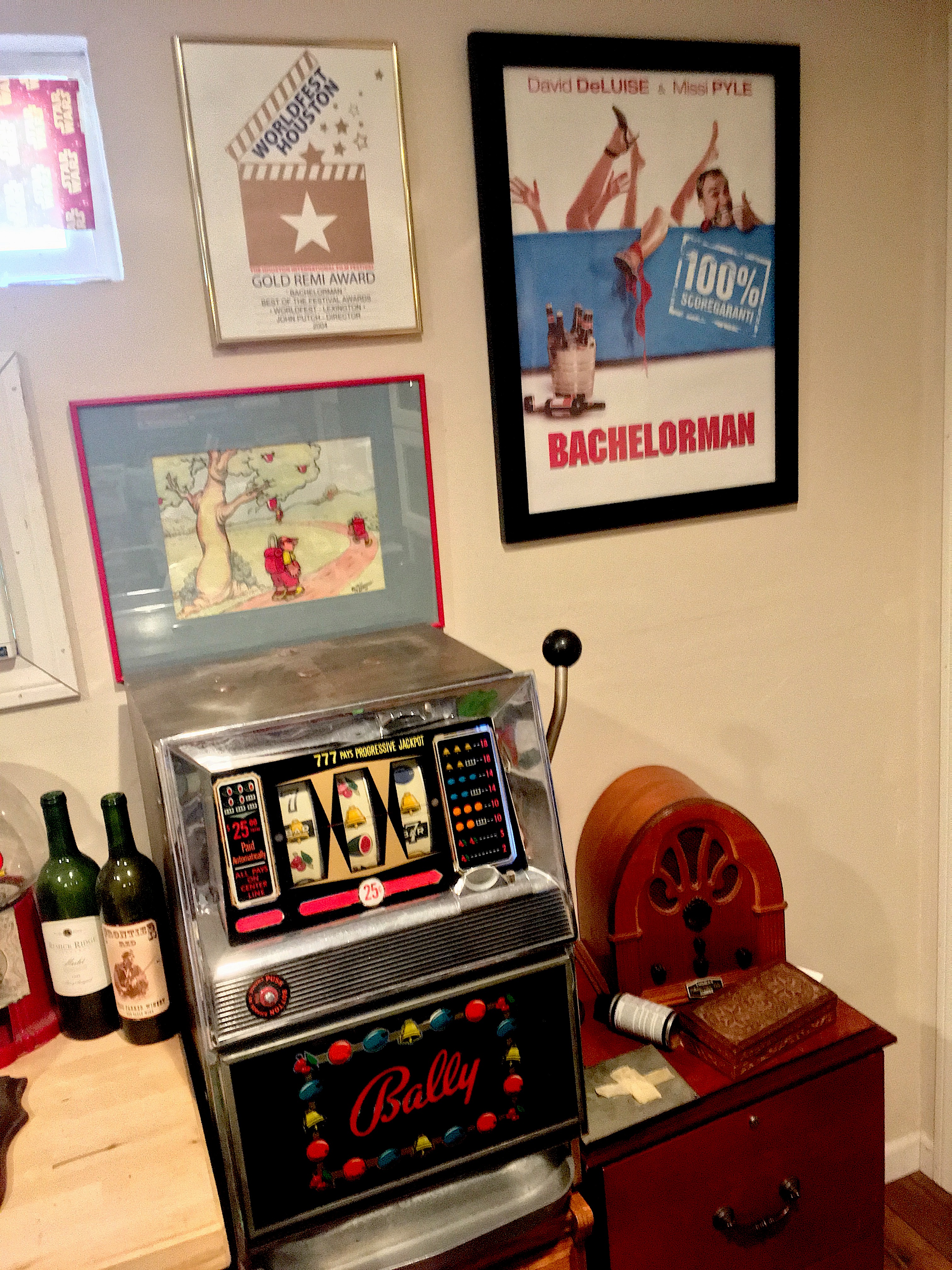 |
- "ONCE BITTEN" (1985, with Dave Hines) is a compendium script of my favorite scenes (for both good and bad reasons) drawn from drafts for the movie (see above).
- "THE DEVIL AND DANNY WELLS" (1987, with Dave Hines) was a TV script written for the DISNEY SUNDAY MOVIE on an electric typewriter (remember those?) as a modern teen version of "THE DEVIL AND DANIEL WEBSTER." It was a screwy process because at 7pm on Sundays, you couldn't refer to God or the Devil, as it might offend Disney lovers of different religious affiliations (i.e., foreign market revenues). That was, of course, problematic for our storyline. We finally solved it (the villain was now from the dreaded "NETHERWORLD!") and turned in our second draft right before a WGA strike. By the time the strike was over (five months later, March 7 to August 7), the 'Disney Sunday Movie' had been canceled and the studio had switched networks, dropping the 2-hour movie premise and using a new hour-long format. So the only thing in the Netherworld was our script. (I'd tell them all to go to hell, but it's 7pm here.)
- "A DREAM COME TRUE" (1991, written with Dave Hines, from a story by Rodney Dangerfield) was written for Dangerfield at Warner Bros. Rodney actually had two ideas for a movie: One was that he would be given a cologne that made him irresistable to women (this script); The other idea was that he would be given a wine that made him a masterful opera singer. We chose the first idea because, honestly, one featured old, overweight, male sopranos singing arias we didn't enjoy, and the other featured hot, sex-crazed women. (YOU hang out in production trailers rewriting dialogue with fat middle-aged male opera singers!) The project ended when Rodney met with the head execs at the studio and demanded more money than they were willing to pay. Rodney went on to insult every executive in the meeting, while we went on to the Unemployment office and wrote a spec script. (Rodney finally did make the wine movie a decade later when he was 82, BTW. We weren't involved.)
- "THE FLUKE" (1992, written with Dave Hines) was another screenplay for Disney, based on our pitch for an Ernest baseball movie. (Remember Ernest?) The idea was that accident-prone Little League coach Ernest takes his team to visit an MLB practice facility and breaks his arm in an exercise machine; after rehabilitation, he can suddenly throw a baseball over a hundred miles an hour and gets recruited by the team. His success strains his relationship with his girlfriend and her son, who plays on the Little League team that he's now neglecting. The producers kept drilling into our heads that Jim Varney was a "classically trained actor" and could handle a heavier role; the result was that when we finished they called and said, "we've decided to make it a real movie, instead" (yes, that's the actual quote), and had us change the character to something that a more typical leading man could play. We did (it's the draft here), but the movie didn't happen, as it kind of fell through the cracks between Disney family product and their more adult-oriented Touchstone Pictures material, and it couldn't find a home. However, a year later, another movie came out called ROOKIE OF THE YEAR. Here's the synopsis: "A freak accident causes 12-year-old Little League player Henry to become such a powerful and accurate pitcher that the Chicago Cubs sign the junior high student to a contract." As Ernest might say, "Hey, Vern, it was a kids' film all along, you dumbass!"
- "EXCHANGE STUDENT" (1993, written with Dave Hines) was a rewrite for Ivan Reitman at Universal Pictures, based on a John Swartzwelder script about a teen-aged space alien who comes to Earth with no special/entertaining powers or abilities to share, playing against audience expectations. Our brilliant idea for the rewrite was that... the alien could do special/entertaining things, and could give the audience what they want. Ultimately the film wasn't made and nobody got what they wanted.
- "TALES FROM THE CRYPTKEEPER: A LITTLE BODY WORK" (1993, with Dave Hines) is our script for an episode of the TV show that ran from 1993-94 (see above). We were even nominated for a Humanitas Prize! Reading it now, I liked this more than I thought I would.
- "FATHER FIGURE" (1995, written with Dave Hines) was based on an idea we pitched for a Chevy Chase movie at Warner Brothers, in which Chevy would find out that he's actually the son of Bugs Bunny, who had escaped into reality through an experimental 3-D process. Warner Brothers loved it and took the story to Looney Tunes animation legend Chuck Jones, who said coldly, "Bugs Bunny would not f*@# a human," thus ending the project... so we made up our own cartoon character and wrote it, anyway. The spec was purchased by Interscope for half a million bucks (which sounds like a lot until you split it with a partner, pay your agent, your lawyer, the Writers Guild, and the tax -- then you're broke after the first rewrite). The project was then killed off by Jim Carrey's film, THE MASK, which had a similar plot. Jim finally had his revenge on us for "ONCE BITTEN".
- "DESPERATE BUT NOT SERIOUS" (1998, with Dave Hines and Rodney Lee Conover) is another compendium script comprised of scenes drawn from various drafts for the film (see above).
- "EXORCIST SQUAD" (1999, written with Dave Hines) was originally optioned by Sonnenfeld Josephson Worldwide Entertainment in 1999 -- they sent it out to all the studios on the same weekend that their Will Smith film, "WILD, WILD WEST," completely bombed at the box office, so nobody bought it, or probably even read it. After that, it was optioned several times by special effects genius Stan Winston's company (2001, 2002, 2003), and then by Fallout Films (2005, to star Wayne Brady and Charlie Murphy). Each version got cheaper (as did the option price). Finally we wrote up a low-budget straight-to-video version that was to star "Baby Got Back" singer Sir Mix-A-Lot. These variations all fizzled (which was probably for the best on that last one). Anyway, this is the first, Sonnenfeld-backed version: A comedy/fantasy about the gates of Hell opening up in Los Angeles, causing crime, riots, fires, etc., and nobody noticing (because hey, it's Los Angeles) -- except for a small, little-known branch of the LAPD called "Paranormal Ops" or "The Exorcist Squad," which performed exorcisms and the like for the city after the Catholic Church washed their hands of the practice due to bad publicity (which actually happened and inspired the screenplay -- this is when I was jokewriting for Leno, Limbaugh, Dees and others and finding weird little stories to use from the back of the newspapers).
- "BACHELORMAN" (2001, with Dave Hines and Rodney Lee Conover) is another compendium script comprised of scenes drawn from various drafts for the film (see above).
- "DOLEMITE" (2007, written with Dave Hines) is a tribute/remake of the epic 1970s Blaxploitation film by Rudy Ray Moore. This Warren Zide production was to have starred Snoop Dogg (as Dolemite) and Charlie Murphy (as Willie Green) before legal threats killed it off. This is the "kitchen sink" first draft, in which we threw everything we could at it to see what would stick: for instance, Reverend Gibbs prays to God to help Dolemite, and we cut to God on a golden throne in heaven as the ultimate pimp, turning his bitches/angels out to assist Dolemite in a gangland battle (we were hoping that Charlie's brother Eddie would make a cameo as God, and he ended up starring in a full bio-pic of Rudy in 2019), but the scene was dropped when Tim Meadows complained that it would cause church protests all over the country -- so Dolemite's all-girl/bitch-angel army was then limited to "Kung Fu Ho's." When the film fell apart (it turned out that Rudy Ray Moore had optioned the property to several companies at once, and his heirs were more fond of a straight-action version with LL Cool J as a Shaft-like detective that had nothing to do with the original films), Zide had the idea of making it anyway, as "BAD, BAD LEROY BROWN," after a Jim Croce song he had just purchased the rights to. However, Dave and I felt the screenplay was too specific to Dolemite. (Plus, we'd have to shoot in the south-side of Chicago -- the BADDEST PART OF TOWN!!!) Then Zide went bankrupt, and it was all over, anyway.

- "BEACH BUNNIES IN CHAINS" (1981, written with Dave Hines): See above.
- "MUSCLE" (1982, with Dave Hines) was written for Dimitri Villard and actress Allene Simmons (1957-2012), who had just appeared in the shower scenes in "PORKY'S" and wanted to turn that timeless moment into a career producing films of her own. )This was before "ONCE BITTEN" sold, so we were still trying to write R-rated drive-in movies at this point.) The plot concerned rival workout businesses in Los Angeles, one a small old-fashioned gym owned by a divorced ex-jock and his plucky girlfriend (Allene), and the other a massive trendy workout studio run by the hero's evil ex-wife (named after my ex-girlfriend). It was the first time we wrote a screenplay that wasn't a teen comedy (I mean, we WERE teens a couple years before, so it only made sense). As a matter of fact, my dad had to sit through two story conferences with us, talking about sex scenes, etc., because he was our only ride up to L.A. in the family station wagon (neither one of us owned a car, yet). Dave and I had no feel for the material at all (case in point: we misspelled "aerobics" throught the entire first draft). When "ONCE BITTEN" sold, we moved on. Allene appeared in a couple more movies, like Dimitri's "TIME WALKER" and "THE MALIBU BIKINI SHOP," but she was most famous for breaking up the engagement of George Hamilton and Elizabeth Taylor during a wild Aspen holiday (1, 2).
- "FOR BETTER OR WORSE" (1985, with Dave Hines) was written for Dimitri Villard and Robby Wald, who had just produced "ONCE BITTEN" from our script. This one was about a young honeymooning couple (named after my sister and new brother-in-law, Kathy and Hal), and based on a story by director Mark Lester, when he vacationed in a beach-side cabin down in southern Mexico and woke up to turn on the light and find that hundreds of rats had silently entered their bedroom during high tide. We added swinging elderly neighbors and a tribe of indigenous jungle dwellers who had appropriated a generator, a jukebox, a disco ball and Elvis music (also based on a true story), as well as drug-runners, tourists lost in the prison system... and casting was about to commence when somebody in the Mexican government actually read the script and decided for some reason that it might hurt tourism.
- "RIGHT HAND MEN" (1988, written with Dave Hines) was optioned by legendary (read: too busy to meet with us) Bud Yorkin, and it became our second project to die during the 1988 WGA strike. It was about two personal assistants to a Howard Hughes-type businessman who dies unexpectedly, and they have him embalmed and stuffed, and run the company in his place. Sounds hilarious, I know ("PSYCHO," but funny), but it had some good jokes, and it was the first time our lead characters were actually adults. Tom Mankiewicz was approached to direct, and he said "It'll either be the funniest movie ever made, or the worst." Betting on "worst," he declined. Bud had our script for a year (in those days you could actually make a living off optioned scripts -- I think we got sixty grand), but his option lapsed during the strike, and by the time we put it on the market again, a movie called "WEEKEND AT BERNIE'S" was coming out and everybody was calling our script a knock-off. So we moved on, to...
- "NUCLEAR REACTIONS" (1989, written with Dave Hines) was optioned by RASTAR (Ray Stark) at Columbia, in a two-picture deal. They took this script, about a remote town in the Pacific Northwest that thinks nuclear war is underway during the Cuban Missile Crisis, and then we agreed to write "PYGMALION 1990" for them, to star Diana Ross and (they hoped) Jack Nicholson. We were thrilled to land our script with RASTAR, but everybody warned us to stay away from "PYGMALION," as in the time since Shaw's play (1913), societal structures had collapsed and the story would be too dated. We decided to use that and turn the play on its head: We made Henry Higgins a formerly-rich destitute bum who had lost everything he inherited in the financial collapse; Eliza Doolittle (Ross) would be a small business owner who had worked her way up from nothing with street smarts, and she would rescue Higgins and teach him how to survive in the modern, classless society (looking back, this wasn't a screenplay -- it was a third act twist to the original play, Hause, you f#@&ing moron). Anyway, RASTAR and Columbia hated our pitch, the deal died, and we took the money and ran to work with Rodney Dangerfield, instead. In the process, it killed this script, too, which would have been a sweet little movie. (How many sweet little nuclear war movies can you think of?)
- "SOUL SEARCHING" (1997, written with Dave Hines) was optioned by LAWRENCE TURMAN (the guy who produced "THE GRADUATE") for the Turman-Morrissey Company. This one wasn't quite as successful as the Mike Nichols/Dustin Hoffman project, but it was fun to meet with Turman and hear stories about that film. He had just produced a Meryl Streep movie with Kevin Bacon, called "THE RIVER WILD" -- so, I was two degrees away, there you go -- and he swore our film would get made, whether as a $50 million Meryl movie or just a $50,000 radio play. Neither happened. In this story, a woman is involved in a car accident at the beginning of the film and then it cuts to her going about her daily life, until discovering she died in the accident and is a ghost at the end of the first act. The story just kind of floated around aimlessly after that, and we changed the plot several times. Turman said it had TOO many twists and wanted us to simplify the story. Then I went to the movies with my girlfriend, Leslie. We saw a new movie with a huge, secret twist at the end called "THE SIXTH SENSE." I watched Bruce Willis get shot in the first scene, then it cut to him going about his daily life. "HE'S A GHOST!" I screamed. Leslie elbowed me in the ribs. Everybody in the theater hated me for giving away the twist ending. I spent the next two hours hating myself, too, knowing our character had found out her fate way too quickly, and wondering if I should send Lawrence his money back. We never heard from him after that. Hello darkness, my old friend...
- "STRIP GIRLS" (1997, written with Rodney Lee Conover): After "FATHER FIGURE" fell through and "SOUL SEARCHING" went nowhere, Dave Hines quit show business. So with my screenwriting partner retired, I was kind of lost. I submitted some ideas to my agent, Steve White, who knew I'd be overwhelmed and intimidated. (I didn't even know if he wanted to represent me without Dave, but he just handled it as if it was any other day at work, which calmed me.) We decided on three projects: "BACHELORMAN" (see above) "GENDER BENDER" (which takes place in a world in which male and female roles are switched), and the aforementioned "EXORCIST SQUAD" as my next projects... and after a few weeks of intense writing on all three... I decided that I HATED writing by myself. So, I wrote this less-ambitious script with my jokewriting partner, Rodney Lee Conover, and director Bill Fishman. It was a send-up of all the stripper movies that were being made at the time ("SHOWGIRLS," "STRIP TEASE," thus the title), as well as any other Las Vegas-based movie from the period ("LEAVING LAS VEGAS," "CASINO," "BUGSY," etc.). It's the closest I ever got to writing a MAD MAGAZINE spoof (since "BEACH BUNNIES IN CHAINS," anyway). For instance, the hero is on a Nicholas Cage-inspired mission to drink himself to death in Vegas, but has been there guzzling non-stop for 19 years without even catching a buzz because the drinks are so watered-down. We actually finished the last 10 pages of the script at the Hard Rock Hotel in Las Vegas over a couple of insane days (Hey, we were RESEARCHING!), minus Bill (who knew what "RESEARCHING" really meant -- turns out the drinks are NOT "watered-down"). The screenplay was optioned by Bill and his brother Jim at Fallout Films for a dollar, and Bill's agent sent the package deal out to the studios. Everybody said it was funny, but there would be no audience for an R-rated strip tease parody, because the intended "Mad" Magazine/parody movie audience would be too young to get into the movie! They also said people go to strip-tease movies to be titillated, and go to parody movies to laugh -- but never for both. This of course was complete studio note bullshit, since we weren't trying to turn anybody on -- we were making fun of movies that did. Kids couldn't get into R-rated "SCREAM," either, but "SCARY MOVIE" was still a hit! Reading it now, it's got some funny stuff, but it focuses too much on lampooning the plots of various Las Vegas-themed movies, and not enough on its own plot or characters to involve the reader -- it takes place during a pitch meeting, the lesson being that bad pitches shouldn't be turned into movies, whether they're intentional or not. Plus, it makes fun of the very production people we were trying to sell it to, which probably wasn't a great marketing strategy. (It turns out that like Dave, I was pretty mad at the movie business, too.) During all this ridiculousness, we also started working with Bill on "DESPERATE BUT NOT SERIOUS", which involved exhausting all-night shoots, crooked execs, insane supermodels (with even more insane acting coaches, rewriting everybody else's dialogue)... but it actually made me love movies again (and brought Dave back in to the writing business, thank God).
- "GOOD THINGS GET BETTER" (2008, written with Dave Hines from a treatment by Joe Dietsch) was a music video for CBS Music, directed by Bill Fishman (who we were working with on "Dolemite.") Keaton is the stepson of actor Eric Roberts and the biological son of actress Eliza Garrett, who was actually pregnant with Keaton when she appeared as "Brunella" in National Lampoon's "Animal House." Anyway, it was a video parody of "An Inconvenient Truth." The trick was to keep it from looking like Keaton was a Climate Change apologist or denier while satirizing the subject matter. The idea of giving all the bad arguments to George Bush came too late in the production, so the final product is a little muddled. Still, Bill is a great director -- it always amazed me how quickly he could turn this stuff out with the schedules and financing the record companies provided. 15 years later, he's still the only guy they'll hire for music videos, which they've otherwise stopped making (90-minute theatrical films are next -- get ready). The video is still available to see online and links are provided on the last page... if the world hasn't ended by the time you've read that far!
|



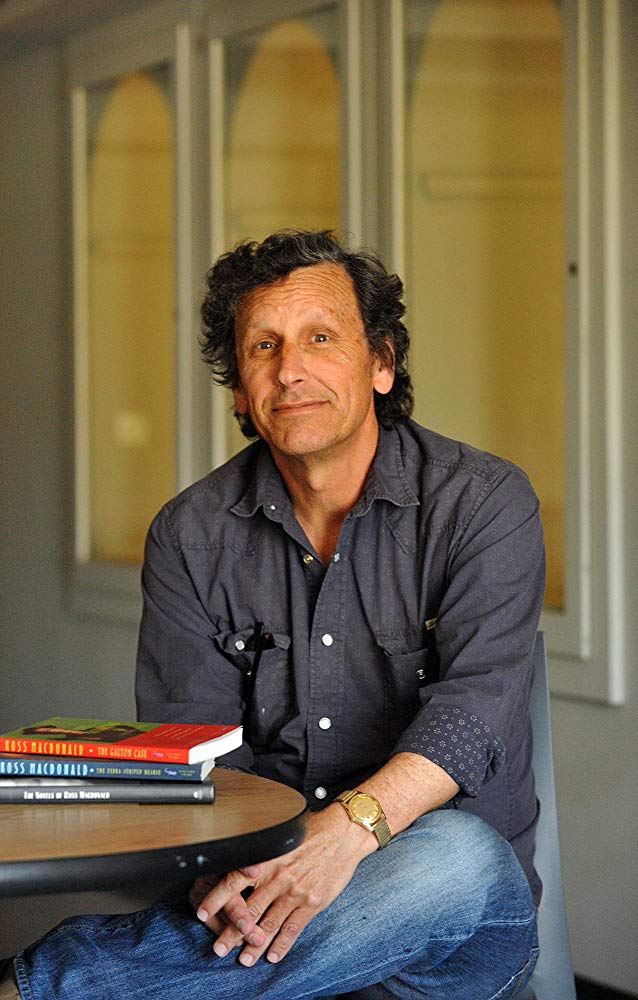
"You put me on your page? Don't do that..." |
STEVE WHITE started his career as a television and motion picture literary agent (that's when he signed us, right after "ONCE BITTEN"), and then was a co-founder and partner in WARDEN, WHITE and ASSOCIATES. The agency became a leading boutique that helped develop movies including "BATMAN," "SLEEPLESS IN SEATTLE," "WILD THINGS," "ENEMY OF THE STATE," and "DEJA VU." The latter was a spec deal worth a record $5 million.
Steve was the only agent we had in 25 years of screenwriting -- alone at first, then with his partner, DAVE WARDEN, in their own agency. We were never great clients for them. We could be arrogant and aloof without having earned the right to be, and for most of our careers we lived 90 miles from Los Angeles, meaning Steve had to do all the work of keeping our names in front of people in the industry. Dave and I never had a sale as big as "DEJA VU," but we did sell a spec for half a million to Interscope in 1995. Most of our deals probably cost Steve more money and time to work on than his 10% of the take was worth -- and from those deals, we only got a film made on the average of once every five years! We were picky about who we worked with and sabotaged projects with people we didn't like (sometimes consciously, although usually not).
On the other hand, we knew we were screw-ups and a pain in the ass, and never called Steve up to complain or threaten, like all of the other writers did to their agents. We were lucky -- and all of the development people we met even told us so. A big agency like ICM or William Morris would have dumped us as soon as they saw what zip code we worked from.
Steve cared -- and for some strange reason, he seemed to like us (for the first decade or so, at least). Maybe because he liked to tell stories about our fuck-ups, like when we re-typed Disney's internal story notes as our own for a horrid script called "HONEY, THE DOG ATE THE KIDS," adding sections like "CAT TURDS: Quark should not eat cat turds over the course of this film." Then we sent the document into Disney as our proposal for a rewrite. (We were submitting for rewrites on five projects in all, and these notes were designed to force them to put us on a different project than this one -- but we got none of the five, because of this stunt. Imagine how ICM would have responded to that.) I heard Steve tell that story at least three times in agency meetings.
Steve was always honest (sometimes brutally so), open and fair, and he would say at least one thing in every meeting that would have me rolling on the floor, laughing. Here are some of my favorite things that he said to us:
- "It's totally original! It's 'BACK TO THE FUTURE' meets 'COCOON'!"
- "We're going to tell them you're a fresh, funny new team. The only other option is to tell them you wrote 'ONCE BITTEN.'"
- "They're looking for writers with some wit and style to carry this thing forward. So try to become that."
- "You guys aren't close to being aged-out of the business, yet. By the way, Jeff, you should dye your hair brown before every meeting. Dave, you should always wear a hat."
- SET-UP: The phone rings after a meeting in which we think we did pretty well. There's an uncomfortable silence on the other end. Finally, Steve says quietly: "Don't do that..." (This happened more than once: See the "HONEY, THE DOG ATE THE KIDS" incident, above, or the inflatable sheep sex doll incident, below.)
In 2007, Steve stopped working as an agent and transitioned into producing, overseeing the estate of crime writer Ross Macdonald, whose books had been turned into movies like "HARPER" and "THE DROWNING POOL" with Paul Newman. Steve is currently the Executive Producer on the Warner Bros. film, "THE ZEBRA-STRIPED HEARSE," written by Joel and Ethan Coen, based on MacDonald's book of the same name. He has also produced a number of Hallmark Christmas movies, which I find astounding. Steve always hated Christmas because he couldn't sell any scripts while everybody was gone for the holidays. Now he makes his living off that holiday!
When Steve left the agency, Dave and I were nearing fifty; I was getting married and moving to Napa, David had just gotten divorced a second time, and we had pretty much stopped writing. The spec market had dried up (it's totally gone, now). Our last assignment, "DOLEMITE," was handled by Warden, but the project fell apart in 2009. After that, Dave and I only worked as consultants when friends called with script problems. The last few projects were films that I wouldn't have had any interest in seeing at all, if I hadn't worked on them. Screenwriting had stopped being fun. Our method of working was out of favor, and we were way too old to re-start our careers as TV gag men (we didn't want to work in writers rooms pitching one-liners, anyway -- we were writers, not performers). But a bigger reason that it stopped being fun was that Steve was gone. I really miss that guy -- much more than he misses me, I'm sure.
|

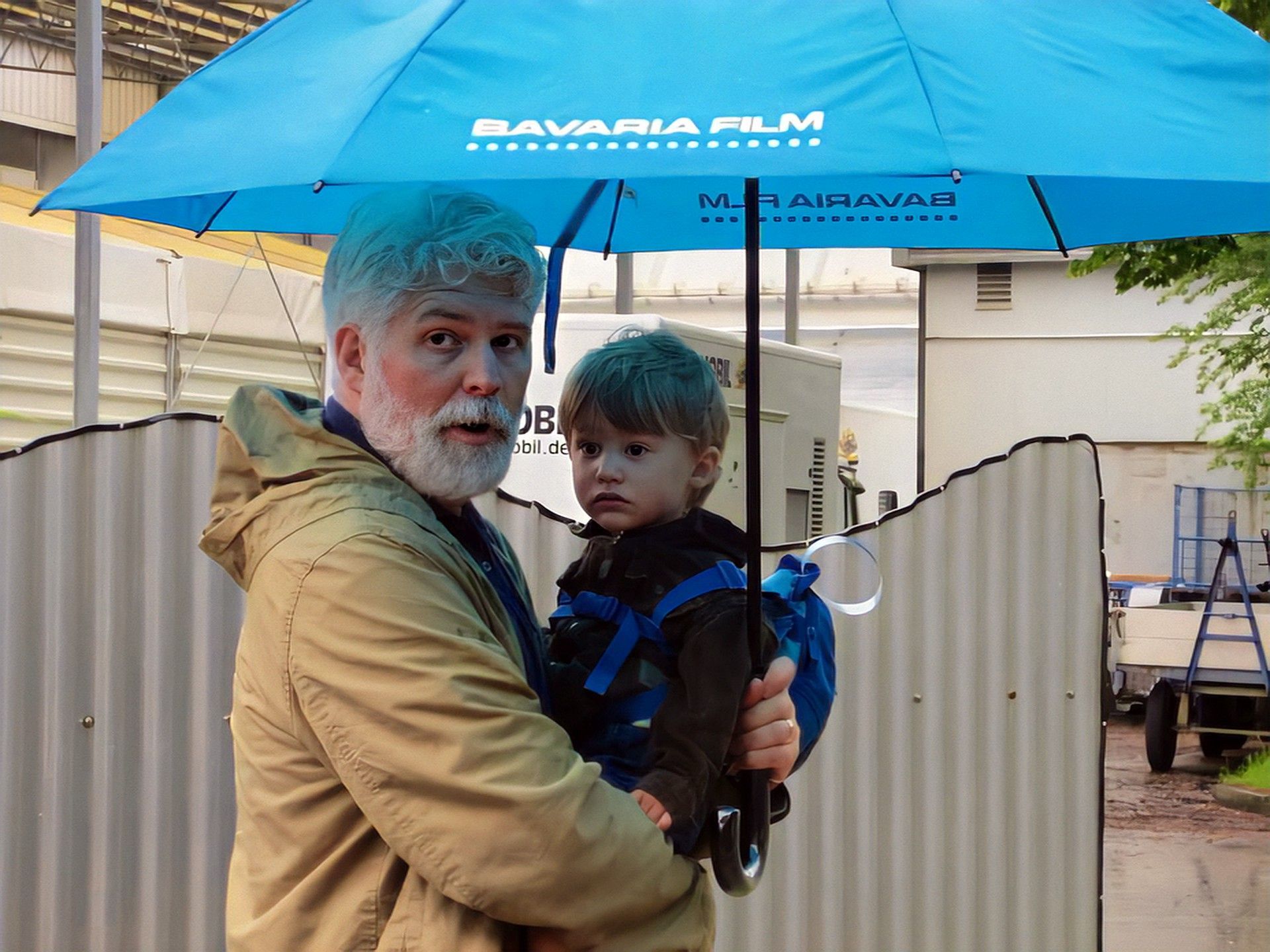
"Behold, my son! This is the business your dad will never allow you to enter!" |
I've gotta say, when I look back on my time in the movie business, I don't miss it a bit. After quitting, I got married, moved to Napa, and started a family (I live back in SoCal now, but with a steady paycheck and health insurance for my kids). I see now that I was walking around in a perpetual nervous breakdown state, promoting and sabotaging my career, often simultaneously:
- I remember screaming at a perplexed Jim Carrey, while he grabbed a snack at the food cart between takes, that everybody working on the production of "ONCE BITTEN" was a talentless a-hole except him, and he was the only good thing in the movie. (You can't say I was smart saying that, but you can't say I was wrong, either.)
- I remember taking a date to see "ONCE BITTEN" without telling her I wrote it, then watching her face as the credits played.
- I remember renting my own movie to Sam Goody customers for minimum wage after I negotiated a deal for that film without an agent or lawyer. (Sam Goody definitely paid more per hour.)
- I remember one of the customers returning "ONCE BITTEN" to Sam Goody saying, "Whoever wrote this should never work in Hollywood again" and me yelling, "You got your wish!!!"
- I remember sending an inflatable sheep sex doll and a bolo tie maker to the VP of Comedy at Warner Brothers because we heard he was depressed. (If he wasn't depressed before, he sure was after having to explain the package to studio security in the mail room.)
- I remember working around-the-clock for a week on an emergency rewrite of a bad Disney script called "FLIGHT OF THE NAVIGATOR," to find out that they had only sent us the script because they had named two of the characters after us. "Thanks! We're honored! Wouldn't change a thing..."
- I remember leaving a message for Jay Leno to call me back over a joke payment, then saving his response and arranging to have women I was pursuing check my messages for me while I pretended to do something else. "Jay? Oh yeah, he calls all the time..."
- I remember a pitch for "BACHELORMAN" going so badly that we were ushered out the back door of the producer's office.
- I remember acting out how a character would get stuck during sex and try to take a bath with a foot always outside of the tub for a comedy about a dog getting reincarnated as a man, leaving the guy I was pitching to so offended that HE went out the back door.
Mostly I remember laughing a lot, meeting interesting, talented people, and for five years living a block away from the woman I would eventually marry without noticing her because I was so in my own head. I don't know if this is a love letter to Hollywood for my children to read one day, or just a warning... but here it is.


- COMEDYONTAP.COM ARCHIVE (1995-2007): ComedyOnTap was a humor service I owned with Rodney Lee Conover. Originally we created humor content for shows on Sony's SW Netork, then wrote jokes for people like Jay Leno, Jay Thomas, Rick Dees, Rush Limbaugh (sorry), and various morning TV and radio shows. Eventually we turned it into an Internet service with a newsletter going out to 2 million people. It also had a website that featured more in-depth content, featured here.
- "THE SCRYPT OF TERROR" details the making of an episode of "TALES FROM THE CRYPTKEEPER" that I wrote with Dave Hines in 1993, that plainly lays out why kids' TV in the 1990s completely sucked.
- "DAVY CROCKETT FROM STUMP TO SCREEN" (UPDATED) traces the changes in American culture through the evolving portrayals of Davy Crockett, from woodsman to hobo to Cold War patriot to Reality Star.
- "WHAT ABOUT MISS MONEYPENNY?" (UPDATED) is a compendium of James Bond trivia that fans pretend is too far beneath them... but I know who you are! You aren't so cool!
 SPORTSHOLLYWOOD.COM ARCHIVE (1999-2007): SportsHollywood was a sister-service to the Comedy On Tap service that I owned with Rodney Lee Conover, producer Rich Hull, and actor Ed Marinaro. It covered the intersection of sports and entertainment in media, with a focus on celebrity interviews, movie news, columns, and comedy features, with a newsletter that went out to about 500,000 people. When the bubble burst on Internet advertising around 2001, SportsHollywood struggled on for a couple of years, then quietly petered out around 2005.
SPORTSHOLLYWOOD.COM ARCHIVE (1999-2007): SportsHollywood was a sister-service to the Comedy On Tap service that I owned with Rodney Lee Conover, producer Rich Hull, and actor Ed Marinaro. It covered the intersection of sports and entertainment in media, with a focus on celebrity interviews, movie news, columns, and comedy features, with a newsletter that went out to about 500,000 people. When the bubble burst on Internet advertising around 2001, SportsHollywood struggled on for a couple of years, then quietly petered out around 2005.- THE REAL "HOOSIERS" compares the movie with the real game that inspired it.
- THE FIELD OF DREAMS details our efforts to stage a reunion catch at the actual film site in 2000.
- PRE-HISTORY (COMPARING THE PREFONTAINE MOVIES) compares two movies from the same year, about the same person, portraying entirely different lives.
- L.A. BASEBALL BEFORE THE DODGERS: The AAAA (that's right, it was QUADRUPLE-A) Pacific Coast League featured players like Ted Williams and Joe Dimaggio before the MLB had any teams on the West Coast. These articles were reprinted in a couple of senior living magazines, which was the first sign that I wasn't writing to the prized 18-30 demographic anymore.
- THE HOLLYWOOD STARS were owned by Gary Cooper, Cecile B DeMille, William Frawley and a host of other stars, and played at Gilmore Field where CBS now stands. Angry Young Ranch was looking to make a documentary film from these articles, and is still looking for funding -- so send 'em a few bucks, okay?
- THE LOS ANGELES ANGELS were owned by the same family who owned the Cubs, snd played downtown in Wrigley Field West.
- THE VERNON TIGERS were owned by Fatty Arbuckle and played in what is now an industrial wasteland.
- "BIG MO" tells the true story of a star basketball player who was paralized from an injury during the NBA's pre-pension/medical plan days and had to be adopted by a teammate to pay his medical bills and survive. For a time this article was the inspiration for a movie project from Academy Award winning writers Bobby Moresco and Paul Haggis, but it's currently in limbo.

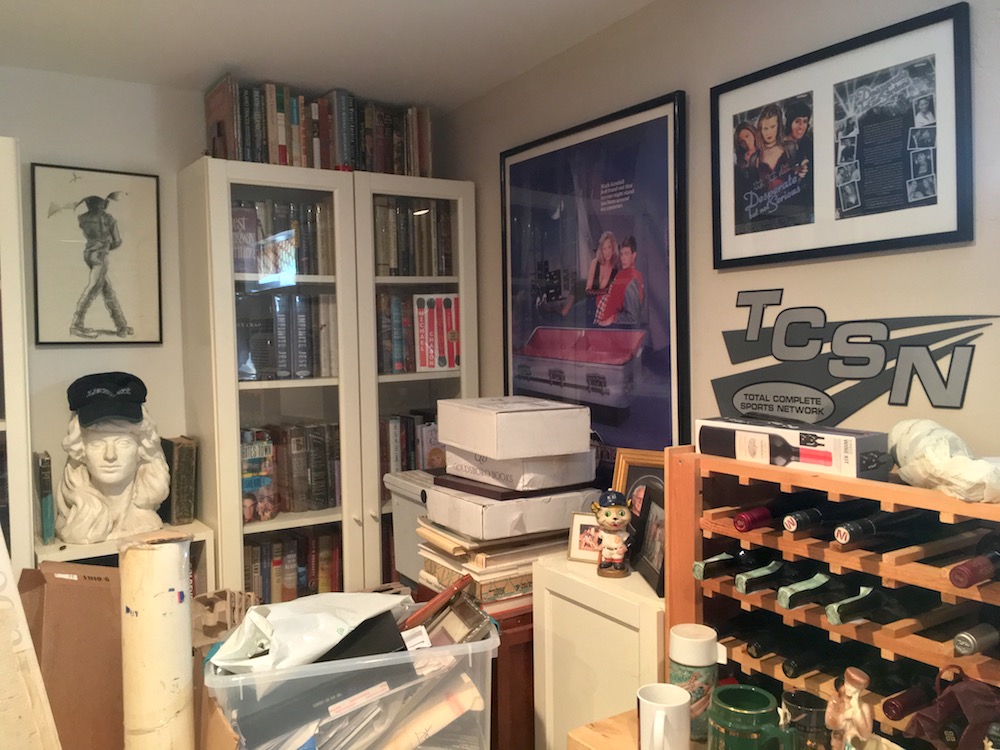 |
- SARAH SILVERMAN (SportsHollywood) answers a dozen questions and insults my mother, throughout.
- RYAN REYNOLDS (SportsHollywood) almost quit acting once--would the loss of the Green Lantern be worth the loss of Deadpool?
- GARRY MARSHALL (SportsHollywood) on playing hardball in Hollywood.
- HARRY SHEARER (SportsHollywood) explains that if an Olympic sport involves wearing makeup and playing show tunes, it isn't really a sport.
- DUCKMAN (series creator EVERETT PECK) answers a few questions about what he's been doing since the TV series (SportsHollywood)
- EDDIE LEBEC (SportsHollywood) of "CHEERS" answers 10 Questions in a seance, through actor JAY THOMAS.
- TRACY PHILLIPS (SportsHollywood) is a beautiful burlesque dancer and choreographer -- and she's the daughter of a winning Superbowl coach. So yes, she is the perfect woman.
- 2001 TOYOYA PRO/CELEBRITY RACE at the Toyota Grand Prix of Long Beach is probably my favorite SportsHollywood memory. I got to interview WILLIAM SHATNER, JOSH BROLIN, PIPER PERABO, a bunch of other celebrities, and then a professional driver gave me a tour of the racetrack (essentially, downtown Long Beach) at 130 miles per hour. The windows were knocked out and I noticed there were no side view mirrors on the car. The driver explained that they were having a contest while transporting the journalists to see who could get closest to the cement barriers, and they had all been torn away during the rides.

(1980-2010) on a variety of topics... like girls... life... and how much life sucked when there weren't any girls...
| "I'M TIRED OF BEING JEFF HAUSE - THERE'S NO MONEY IN IT" (1990): I got incredibly lucky when I left high school. I signed up at the closest community college, Palomar College in San Marcos, CA, and it just happened to have an AMAZING art department. The illustration instructor was EVERETT PECK, who had worked for Rolling Stone, Time, Playboy, and countless other magazines, and would go on to create the TV show "DUCKMAN." I got to see first-hand how talented and hard-working you really have to be in order to succeed in illustration... and I therefore became a writer, instead. Not to toot my own horn (but, since nobody else is), I posted this on Facebook and a hero of mine, the cartoonist JAY LYNCH, compared this drawing to the work of HEINRICH KLEY (or maybe he just meant that I looked like Heinrich Kley -- should've asked)!
|
| "EINSTEIN'S SECOND THEORY OF RELATIVITY" (1982): Everett Peck encouraged all of his students to carry a sketchbook everywhere. It was hard for all thirty of us to hold it at the same time, so I eventually bought my own. My earliest sketchbooks were heavily influenced by, you guessed it, Everett Peck, minus the skill and style. Everett is a pen and ink master, and has an amazing ability to create loose-looking drawings that are INCREDIBLY precise. Everett has that ability, Picasso had that ability... I do NOT have that ability -- mine veer between sloppy and massively overworked. This was one of my first pages, trying mightily to copy Everett's style, and failing, but the joke's kinda' cute...
|
| "PLANES OF THE HEAD" (1981): While at Palomar College I lucked into a semester with another great artist named JOHN ASARO, whose figurative paintings are highly sought after. Asaro broke the human form down into planes (creatively, not literally, thank God). Asaro had just left a teaching gig at Art Center to move south, and taught at my JC for two semesters. I did this drawing of a basic head sculture he created, then added the overlay in Everett's class.
|
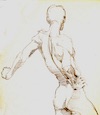 |
FIGURATIVE SKETCHBOOK DRAWING (1983): Transferring to Long Beach State, I took classes with another great artist, JOHN LINCOLN. Our first meeting was not auspicious. He watched me draw a model for a few seconds, then grabbed my newsprint drawing pad and threw it out of the second floor window. He then made me go to the store and buy better paper. While Asaro had stressed anatomical knowledge, Lincoln made me concentrate on line quality and the idea behind the drawing in its composition. Up to that point, the only idea behind my drawings was the joke I was trying to illustrate, and the quality of the graphics came a distant second. "Distant second" in Lincoln's class got your drawing pad thrown out of the window, again. I did this one in an 11"x14" sketchbook, which he generally didn't throw out of windows for fear of hitting a pedestrian and getting sued. In this drawing I excluded the staff that the model was balancing on, giving the impression that he is off-balance or about to fall. Isn't that interesting? No? Throw your screen out the window -- see if I care... Jerk!
|
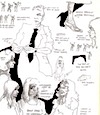 |
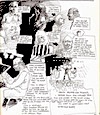 |
ON THE SET OF "THIS IS SPINAL TAP" (1983): My neighbor in the dormitory at Long Beach State, Jamie Murphy, had a cousin in the film business named Karen Murphy. She was the long-time business partner of Rob Reiner, who was directing his first movie. One day Karen invited her cousin to the set, and he brought me along. We witnessed some amazing things: Reiner directing the sequence in the film at the Air Force base, with Fred Willard improvising an entire tour of the hangar, on the spot. Harry Shearer and Christopher Guest devising an airport scene with a cucumber. Somebody then slipped a comic book I had written to Reiner, and he read it between takes. Finally, he called me over and told me how funny it was. Being a snotty 21-year-old kid I immediately pressed my own screenplay onto him (that I just happened to be carrying -- really), in a breach of all on-set etiquette and common sense. Sighing, he told me to leave my sophomoric, over-written pirate (!) script in his trailer, and he went back to directing a brilliant movie that had no script at all. Reiner went on to direct a fantastic pirate film called "THE PRINCESS PRIDE," and I... went on to watch his fantastic pirate film called "THE PRINCESS PRIDE" -- and never heard from him again.
|
| ROBIN POLO (1983-84) was a girl living in the next dormitory at Long Beach State. Robin was so gorgeous -- she had been a Princess in the Rose Parade and she literally glowed with vitality and beauty. As for me, the only thing I glowed with was colored ink and paint stains on my clothes, which had all turned pink in the wash, anyway (it was my first time living away from home, and I was laundry-challenged). I developed an intense, unrequited crush on Robin, to the point that when Dave and I wrote "ONCE BITTEN" during my first semester in the dorms, we named the female love interest after her. These two drawings were from a drawing session in my dorm room. She studied art history, and I studied her. (Lincoln thought the first one was overworked -- he liked the second one, though; so he didn't throw this sketchbook out of the window!)
|
| DEATH (1983): Both of my grandfathers died while I was at Long Beach State. One lived much longer than anybody expected, while the other's life was cut much shorter than expected. Both died way too soon for me. My sketchbook drawings grew very dark at this point, both in subject matter and in the amount of ink that I poured onto them. I lasted one more semester in college, then dropped out after selling a screenplay and becoming a professional (heh-heh) writer. I was still able to take one of my grandmothers to see my first film when it was #1 at the box office (the other lived in Michigan, but she sent me newspaper clippings -- no reviews, fortunately). Anyway, these were two of the drawings from my sketchbook from the time of their deaths that still have some white paper visible.
|
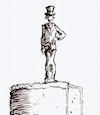 |
JILTED (1984): So, the relationship with Robin Polo ended as you might expect. I named a character in our script after her, and then Goldwyn made me quit school by threatening to dump us and hire full-time writers. So Dave and I moved to Beverly Hills for a month, I bought non-pink clothes, and I visited her at school in my off-time. I even took her to a production meeting for the movie in Goldwyn's offices (in one of the seedier moments in my career, one of the producers offered me $500 to watch us fool around), but I never stood a chance... the movie I wrote for her went to #1 at the box office, and she still went ahead and married the guy she had been engaged to the whole time she had been at Long Beach. He turned out to be a great guy -- he pitched in the Dodger organization and gave me some good locker room stories to use in a baseball screenplay that I was co-writing for Disney. A handsome baseball pitcher with great stories -- I might have married him if she hadn't. Anyway, they're still married and raised three kids -- and she still hasn't seen the movie!
|
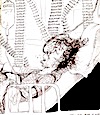 |
'ONCE BITTEN' SKETCHBOOKS (1983-86): We negotiated our own deal with Goldwyn for "ONCE BITTEN," so by the time of our second rewrite we were totally broke. Not only had we negotiated an extremely bad deal, but the producer had our checks stopped when they didn't like our first rewrite. I was being treated for ulcers at this time, and ended up in the ER for exploratory surgery... and the "ulcers" that everybody assumed I was developing turned out to be a bursting appendix that exploded on the operating table. When awakened in my hospital room the next morning, barely alive, the phone rang. It was the producer, asking when the next draft would be ready. A year later, the film came out and debuted at #1 in the box office. I drove past it every morning, on my way to work at the video counter of Sam Goody for minimum wage. (Public Service Message: "Stay in school, folks!") Here are a few more drawings from my sketchbooks during the writing, production and release of the film... and then a few more when I had blown through all of my money and I was working at the video store. |
|
|
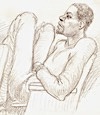 |
WORLD SERIES SKETCH (1988): My family was from Michigan, so I grew up rooting for all of the Detroit sports teams (and I was born on the University of Michigan campus, so I have a soft spot for their teams, too). So when my personal baseball hero Kirk Gibson left the Tigers and signed with the Dodgers, I started rooting for that team, too. Gibson was the MVP that year and led the team to the World Series... and Dave's brother-in-law scored us tickets three rows back from the dugout on the first base side... for the 2nd game. So while I missed Gibson's famous home run in Game #1, I did get to see a standing ovation for him before the game, and watch another Dodger victory (Dave was an A's fan -- sorry, Dave). Anyway, 3 seats away from me, with nobody in between, was Magic Johnson, Laker hero (and Michigan State star, BTW). They kept showing him on the Jumbotron and everybody cheered each time. Unfortunately, I was sitting next to him wearing a Detroit Pistons shirt, and was trying to stay out of frame so I didn't get booed. How he squeezed a 6'9" body into that seat, I still have no idea.
|
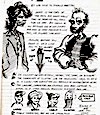 |
VIRGINIA GIRITLIAN (1988) was a Development Exec for Bud Yorkin when they optioned our script "RIGHT HAND MEN". She was very attractive and funny and she thought I was talented, for a gangly, 25-year-old dork with a bad haircut and very little screenwriting experience who couldn't pitch and still lived with his parents -- so I thought we were an obvious match. (You can tell where this is going, can't you?) She asked to read another script we were writing for Disney, and I thought I would charm her with this attached letter. I was very into being self-deprecating, to such a point that most women eventually went, "I get it, you suck. Anything else?" Anyway, she was very kind and didn't say that (she even had this drawing framed on her desk), and when "RIGHT HAND MEN" couldn't find a studio, helped us prepare a pitch for our next screenplay. Then we went on strike with the WGA for several months, Yorkin's option lapsed, and we never saw her again. Now, looking at this drawing, it's apparent that my self-esteem was pretty low, but wow -- I did not like the look of myself at all!!! (Or Dave. Once again, sorry, Dave.)
|
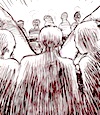 |
DIRTY DAN'S (1990): Hey, I'm not proud of it, but when you work behind a desk in your townhouse writing screenplays and jokes all day with the window shades closed so you don't get distracted, and you finish at 11pm feeling stir-crazy, you end up in places like this. Staring at strippers beats staring at drunk, belligerent people with all their clothes on inside a bar (although if you tipped drunk, belligerent people with dollar bills like strippers, they might smile at you, too). We were getting decent money for our screenwriting, but when those scripts aren't getting shot you aren't hanging around any actresses or cute D-girls (not that they would be going out with me, anyway). I went out with several strippers over the course of the 90's, as well as a couple of barmaids (who actually hated horny guys more than the strippers -- and I should know). This was a drawing done while I was waiting to pick up my date, "Sasha" (stage name). And the guys in front of me saw more of her than I ever did. BTW, this was six years before "PULP FICTION." I wonder if this drawing influenced the way Tarantino shot the open briefcase...
|
| WORKING WITH DISNEY (1988): Dave and I worked with Disney twice over the years (and picketed there once with Richard Lewis and the Professor from "GILLIGAN'S ISLAND" for a Guild march -- until one of the writers got too hot and phoned in an anonymous bomb threat in order to break up the protest. There are two sides to the Disney film division: the creative side and the legal side, and they keep the two sides totally in the dark about what the other is doing. That way, you can have a great relationship with the creative team while a corporate lawyer calls your agent and says that unless you want to wait another six months for your money, you will have to accept only 33% of your agreed price, today. Then they fire the creative team and you are suddenly an unwelcome stranger to everyone in the building, who now hate every albatrossian project that was being developed by their predecessor, like yours. "The Happiest Place On Earth" is definitely the park -- not the studio.
|
| COMMERCIAL WORK FROM THE 90s: I was still doing graphic work occassionally during the early 90's. The drawing on the far left was an ad/window sticker for a local surf wax company that I drew an accompanying comic book for. The owner of the company was an old-school longboard surfer who liked to wear a viking helmet and get into fights. Fortunately he liked me as an artist more than a sparring partner and and gave me this job. He also owned a great record store, where I worked for a couple summers between screenplay jobs. I had a great time making the comic, but struggled to find a decent way to draw black and white waves. (Kinda' violent for a newspaper ad, too.) The second is an ad for a production of the Larry Gelbart play "MASTERGATE," performed at the North Coast Rep in San Diego. The play was funnier than the drawing.
|
| THE CIRCLE OF LIFE (2008): Occasionally I'll still sketch up an idea onto an envelope or doodle onto a napkin in a restaurant, but I got out of the habit of journaling while writing screenplays, because I'm still thinking in pictures when working on a film, and by the time I'm alone and can draw, what's left of my creativity is asking for rest, junk food and a TV show. Anyway, here's one that somebody wanted for a tattoo. I talked them out of it -- making all those little fish would hurt!
|
| TRAVEL SKETCHBOOK (2009): Once I got married, I gave up screenwriting for the most part and started to travel. When I was young my family always traveled to see people, not places. But my wife encouraged me to go for the experience. So in 2009 we went to Spain, Portugal and Morrocco. There was a swine flu epidemic going on in Madrid, so everybody was wearing facemasks. I brought a sketchbook and did some hasty, scratchy drawings, then doctored a few digital photos and pasted them in. Morrocco was magical, but modern culture was seeping in -- I witnessed a solitary Berber riding his donkey out of the hills to sell his hand-made wares at the kasbah -- while screaming into his cellphone like he was a driver stuck in rush hour traffic on the 405 freeway in LA.
|

| COMIC BOOKS (1979-1990): These were printed over the course of a decade. The first was created during my senior year of high school, and was financed by my psychiatrist, George Sargent. A teacher at my school had seen one of my drawings and it was recommended by the school counselor that I seek therapy. Fortunately, the guy they sent me to realized that I was just a goofy kid trying to shock people into laughing and actually encouraged me to do more cartooning. (Here's an abandoned wrap-around cover.) The second comic book was done in college, and I sent a copy with a fan letter to my hero, cartoonist R. CRUMB, and got a nice response, not counting the part in which he says I look like a girl, and need to get a haircut. The third comic was a job for a surf wax company. For those who care (i.e., me), this comic was illustrated with a brush instead of a pen, so the waves would flow better.
|
| MY FIRST MOVIE (1981) animated; This is humiliating because it's so amateurish (okay, it's not like the rest of this stuff is polished, but this is REALLY amateurish), and the only animation that I ever attempted. It's triply-humiliating because not only was Everett Peck the instructor, but one of my classmate was RON HUGHART, who would go on to direct "REN AND STIMPY," "FAMILY GUY," and a million other things. At the end of the semester, Ron turned in a beautiful, 5-minute film, perfectly syncopated to music. I turned in this mess. On the bright side, while the background for the photo is one I did to frame it a few years later, the real, far-superior background for the actual film is by a brilliant artist named LENNIE MacDONALD, who is now a successful special effects guy in Hollywood, and his work probably got me a far better grade than I deserved from Everett. You can see the whole movie here. |
| "BEACH BUNNIES IN CHAINS," ILLUSTRATED (1981): This was a series of illustrations that we turned into the producers with our first screenplay assignment. I obviously had no idea that budgeting mattered, or the difference between animation and live action, because this stuff wouldn't have helped the filmmakers at all. "Okay Jeff, we WILL build the 'Terrorist Club' with the massive water fountain out front with statues of gunmen shooting each other and water shooting out of bulletholes like blood! And yes, we WILL have the waitresses inside delivering smoking Molotov cocktails on drink trays with actual fish wriggling around in their fishnet stockings! Thanks for your guidance!" |
| RODNEY DANGERFIELD: In 1990 Warner Bros. hired us to write a screenplay with Rodney. Meanwhile, I had re-enrolled at Long Beach State to get my illustration degree. I did this watercolor of Rodney for my night class. I wish I could tell you that it was a life study, but the VP at Warner Bros. wouldn't allow us to write with him because, "he's crazy." While we wrote the script, Rodney sued Caesars Palace in Las Vegas when his eyes were burned in a hotel steambath (they claimed he was stoned). Rodney would show up at his office in the studio every day wearing a blue terrycloth bathrobe with nothing on underneath. One producer met with him as he rode an exercise bike and was afraid Rodney's testicles were hanging so low that they were going to get caught and wrapped up in the gears. So this painting is at eye-level. You're welcome. |
| "BACHELORMAN" SCRIPT COVER (1994): On the day we turned in the script, we had couriers from eight production companies waiting at Steve's for a copy of this script, ready to bid. We had just sold a spec for half a million dollars and we were "hot." By that afternoon, we were no longer "hot" and Steve called us to say he was pulling the script. One producer called it the most offensive script that he had ever read. Ten years later, we finally got the film made and it was actually accused of being too safe and sitcom-like (we had no money, so it was shot on stages like a sitcom). Were we 10 years ahead of our time or 10 years behind? You decide. (FYI: The essential 1994 bachelor supplies in the drawing were: Hair protein, Michael Bolton tickets, condoms, car key fobs for Ferrari, BMW and Lotus, crotch stuffing, and a "Dumb Things I Gotta Do" list with "Eat," "shit," and "sleep.") |
 |
LIFE DRAWING STUDIES (1980-2000): I love to draw people in real time -- no photographs, no plaster models, and no artfully-obscuring clothing. You just concentrate on the anatomy -- where the muscles and tendons connect; how they hang on (or off) the bone. John Asaro taught me how the body curves and connects, how flexing one muscle affects another muscle, and why the anatomy works the way it does. John Lincoln pushed me to take what I had learned and apply it to artwork, i.e., convey an idea with a line instead of just copying form. He once said, "That's a virtuoso line," (being kind so I'd listen) then added, "but WHY IS IT THERE?" That question really challenged me to think as I drew instead of just copy, but frankly I'm still not sure why ANY of these lines are here, except they were fun to make. There are also a couple of drawings I made of girlfriends. These are generally unfinished because, well, I had a naked girlfriend in front of me, so the idea I was conveying to her had nothing to do with drawing. |
|
|
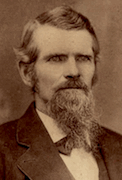 |

|

DEAR READER: This page isn't linked to any other page I have. It's only here for people who care about any of this crap enough to search for it. It's an offshoot of a genealogy site that I created for my family which traced all the descendants of my ancestor, William Hause. I had posted some of my film work on that site, and it just seemed weird to have "HAUSEGENEALOGY.COM" as the address for movie pages, so I made this site to hold them, instead, and now it's becoming something of an archive: an accumulation of ephemera buried deep in the dusty corner of a tiny mouse hole in a forgotten corner of an abandoned reading room sitting inside an crumbling library lost along the vast labyrinth of portals connecting the collective knowledge of humankind that we call the Internet.
So it's basically just an organizational tool/exercise for me that nobody else would even care to find... but if you've just wandered onto this page by accident... I hope you like it, too!
|

© 1980-2023 BY JEFF HAUSE         Logo Design: https://de.cooltext.com/Logo-Design-Gold-Outline; https://de.cooltext.com/Crazy-Killer
Logo Design: https://de.cooltext.com/Logo-Design-Gold-Outline; https://de.cooltext.com/Crazy-Killer
|